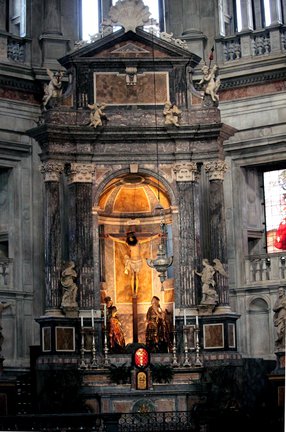Cappella del Crocifisso
La Cappella del Crocifisso è di architettura identica a quella delle due precedenti absidi. La costruzione fu diretta da Carlo Buzzi ingegnere del Duomo di Milano dal 1653. Il luogo fu predisposto demolendo parte del Pretorio, palazzo del Podestà.
Sopra l’altare sta il prezioso gruppo ligneo rinascimentale di Giovan Angelo Del Maino.
La calotta absidale è dominata dal gruppo barocco del Cristo risorto e angeli dello stuccatore Agostino Silva di Morbio
La grandiosa ancona di marmo fu iniziata nel 1781, architetto Antonio Donegana secondo la testimonianza del conte Giovan Battista Giovio.
Nelle nicchie dell’abside sono presenti quattro statue: a sinistra i Ss. Apostoli Pietro e Paolo di autori non identificati (sec. XVII); a destra le cinquecentesche e classicheggianti S. Agnese e S. Sebastiano. Il S. Sebastiano, a lungo attribuito a Cristoforo Solari, è invece opera documentata di uno degli scultori della Fabbrica del Duomo, Matteo da Annone (1522), scoperta recentemente, la S. Agnese (circa 1520-1530) è ipotizzata opera di Gaspare Annone, padre di Matteo, e probabile capo-bottega.
Le due vetrate dipinte sono novecentesche: a destra Gesù nell’orto degli ulivi (1900), pregevole opera del pittore paesista milanese Filippo Carcano, offerta da Giuseppina Camozzi Baragiola a sinistra la Pietà, ispirata al gruppo di Michelangelo in S. Pietro, prodotta dalla ditta milanese Corvaya e Bazzi (prima del 1914).
Sopra il tabernacolo il reliquiario d’argento a forma di croce chiuso da cristalli progettato dall’arch. Federico Frigerio fu collocato nel 1939 dal vescovo Alessandro Macchi: contiene una reliquia del legno della Croce proveniente dalla distrutta chiesa di S. Nazaro (ex quartiere della Cortesella) fin dal 1083 postavi dal vescovo Bertramo da Brossano.
Nel 1666-68 si plasma la stuccatura del gruppo del Cristo Risorto all’interno della calotta. Lo scultore-plasticatore è il ticinese Agostino Silva di Morbio, figlio di Francesco, il quale aveva realizzato l’Assunta nella cappella opposta. Il grandioso gruppo composto da angeli che accompagnano Gesù verso il cielo ha nel centro proprio la figura del Risorto che si staglia su una mandorla, motivo medievale dipinto nei catini absidali con il Cristo Pantocrator. Qui la mandorla è parzialmente leggibile perché interpretata baroccamente con il disporsi di raggi dorati tutt’attorno e gli svolazzi del sudario che vorticano attorno al corpo glorificato di Gesù. La figura del Risorto è nella stessa posizione che si ritrova in più modeste dimensioni nell’XI cappella del Sacro Monte del Soccorso a Ossuccio, precedente opera del medesimo Agostino Silva (1664). L’indoratura è in foglia d’oro procurata in Ungheria dai Cernezzi, famiglia di mercanti attivi sul mercato internazionale (1675).
La balaustra su indicazione dell’arch. Quadrio (1672) fu realizzata in marmo nero come quella dell’altare della Madonna).
Nel 1674 fu eretto l’altare, un grande emiciclo di legno dipinto e dorato. Quell’altare non esiste più perché fu rifatto in marmo nel corso del ‘700. Fu infatti scartata l’idea di commissionare un grande crocifisso in bronzo a Bernardo Falcone per il costo levato.
L’emiciclo di legno conteneva il gruppo ligneo della Crocifissione che stava prima nella quarta cappella settentrionale. D’allora lo straordinario gruppo ligneo è rimasto nell’altare del Crocifisso, a lungo anonimo, ma finalmente attribuito allo scultore pavese Giovann’Angelo del Maino dal restauratore Eugenio Gritti (1996) che aveva riconosciuto le medesime modalità tecniche e stilistiche già riscontrate nel restauro dell’ancona di S. Abbondio ora nella quarta campata meridionale. Dopo l’incendio della cupola fu deciso un “abbassamento del gruppo dell’altare del Crocifisso” (1936).
Il card. Tolomeo Gallio, abate di S. Abbondio, nel 1587 donò reliquie dei santi vescovi Adalberto e Rubiano e un braccio di sant’Abbondio, già custodite in questo altare ora in quello di S. Giuseppe.



